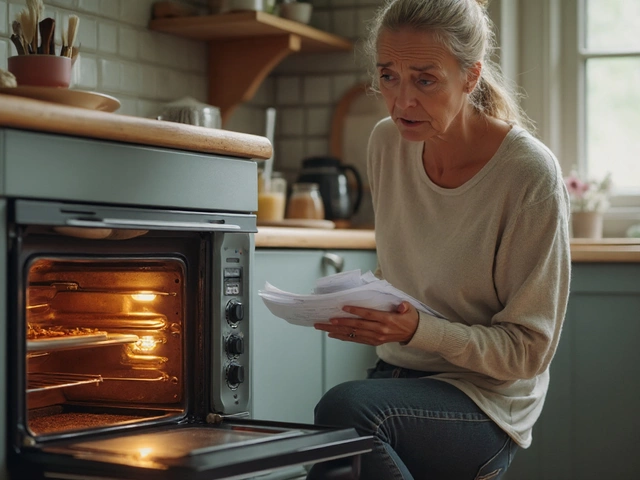If your electric oven isn’t getting hot, the heating element is the usual suspect. Swapping it out yourself can save you a call-out fee and get the kitchen back in action within an hour. Below you’ll find a straightforward walk‑through, the tools you’ll need, and tips for avoiding the most common mistakes.
Gather these items first so you don’t have to stop mid‑job:
Having everything on hand keeps the process smooth and reduces the chance of improvising with the wrong part.
1. Disconnect power. Unplug the oven from the wall or switch off the dedicated circuit at the breaker. Even if you think the element is the only live part, it’s safer to cut power completely.
2. Access the element. Open the oven door and remove the bottom oven rack. Most elements sit behind a metal cover or a plastic shield at the base. Unscrew the cover and set the screws aside – they’re usually easy to lose.
3. Test the old element (optional). Use a multimeter set to the resistance (ohms) setting. Touch the probes to the element’s terminals; a reading of infinity means the element is broken. If you get a low reading, the element may still work and the issue could be elsewhere.
4. Detach the old element. You’ll see two wire connectors clipped onto the element’s terminals. Press the release tabs (or pull the connectors apart) and pull the wires away. Some models have a single screw holding the element in place – loosen it with a screwdriver.
5. Install the new element. Position the new element into the same slot, align the screw hole, and tighten the screw. Re‑attach the wire connectors, making sure they click into place securely. A loose connection will cause the oven to trip the circuit.
6. Re‑assemble and test. Put the cover back, screw it in, and replace the oven rack. Restore power and set the oven to a high temperature for a few minutes. If it heats up evenly, you’re done. If not, double‑check the connections or consider calling a professional.
That’s the whole process. It usually takes 30‑45 minutes, even if you’ve never done it before.
While many homeowners can replace an oven element themselves, there are a few situations where it’s smarter to call Bognor Regis Appliance Repair Experts. If the oven still won’t heat after a new element, there might be an issue with the thermostat, wiring, or control board. Our technicians know how to diagnose those problems quickly and can get your oven back to full power without a long wait.
Remember, safety comes first. If you ever feel unsure about handling live wires, don’t hesitate to reach out. A quick call can save you time, money, and a potential injury.
Ready to give your oven a new lease on life? Grab the right element, follow these steps, and enjoy hot meals again in no time.

Got a cold oven? Learn if you can swap that faulty heating element yourself, what tools you'll need, and exactly what to watch out for. Easy fixes, with real-life tips.

Neglecting boiler maintenance can lead to a series of unfortunate events, from reduced heating efficiency to costly breakdowns. A neglected boiler could become a safety hazard, potentially increasing the risk of carbon monoxide poisoning. Regular servicing can enhance your boiler’s longevity, ensuring a warm home environment during cold spells. Discover why these routine check-ups are more crucial than many realize and learn how they can save you from avoidable expenses.

Wondering how long it takes to swap out an old boiler for a new one? This article spells out exactly how much time you’ll need, what really affects the timeline, and offers practical tips to speed things up. Get the full breakdown, including what you can do before installation day and how to avoid surprises. If you want your heat and hot water back fast, this guide is for you. Find out what to expect from your boiler replacement and how to stay one step ahead.

Struggling with a hot water heater that refuses to kick on can be frustrating, especially on chilly days. In this detailed guide, you'll find practical solutions and in-depth explanations to help diagnose and possibly fix some of the most common issues that prevent your hot water heater from functioning. Whether it's a simple power issue or a more complex mechanical fault, this article equips you with the knowledge to tackle the problem. It's time to stop second-guessing and start understanding what's really going on with your heating system.

Got an electric oven that's not heating? Discover the most common issues, why they happen, and how you can fix or prevent them without calling a pro.

Extractor fans play a pivotal role in maintaining air quality in kitchens and bathrooms by expelling moisture, odors, and smoke. If your extractor fan suddenly stops working, it can lead to persistent humidity or unpleasant smells. This guide provides practical steps for diagnosing and fixing common issues that can cause an extractor fan to malfunction. From checking power supply and fuses to cleaning and replacing parts, understanding the intricacies can save you time and money. By following these steps, you can restore your extractor fan’s functionality and maintain a comfortable home environment.